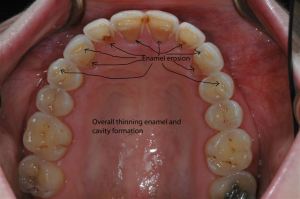Search for topics or resources
Enter your search below and hit enter or click the search icon.
July 31st, 2015 | 2 min read

Although people suffering from eating disorders are usually able to hide this disorder from their friends and family, dentists can always spot the problems. The symptoms are obvious because eating disorders constantly bathe the mouth in acid, which can damage the teeth and the gums. So it’s no wonder that dentists are usually the first to discover these disorders in their patients. There are three major symptoms that dentists look for:

1. Enamel Erosion
This is the most noticeable, and common sign. Acids from the mouth slowly melt away the very hard enamel layer of the tooth. Teeth will thin out and feel very sharp, and chip very easily. If this condition is continued for long periods of time, erosion will also affect the back teeth. Serious issues like tooth decay and damage to the nerves of the teeth is a likely scenario. Eventually, as the biting surfaces melt away, the jaw will get misaligned — leading to serious jaw and facial pain.
2. Trauma to the Mouth’s soft tissue
In addition, dehydration caused by self-induced vomiting will also result in a dry mouth. This will increase the occurrence of red sores, and the mouth will feel as if it’s burning
all the time. Plus, the acid will also damage the delicate gum tissue by receding and exposing the roots of the tooth, causing further sensitivity.
3. Swollen glands
After years of purging, the parotid glands will become swollen, which will make it difficult to eat and also hard to swallow. Damage caused by Bulimia cannot be reversed,
and this eating disorder must be controlled before any dental treatment.
A few tips to minimize the damage:
1) Stay away from soda and fruit juices
2) If you are purging, don’t brush teeth right away (the mouth is overly acidic)
3) Do not use mouth rinses after purging ( mouth rinses are acidic)
4) Do not eat processed foods or junk food (they further promote acidic mouth)
5) Drink plenty of water
6) Brush 30 minutes later
So far, there is no way to grow lost tooth structure, although scientific advances may make it possible in the future. For now, options are limited to restoring what was lost with either porcelain veneers or bonded composite fillings. It all depends on how much of the tooth volume was actually eroded away. Treatment may be as simple a few small fillings or as complicated as placement of numerous porcelain veneers or crowns. At times, full-mouth veneers may be required in order to resurface the lost tooth structure and reestablish the correct bite position, alleviating any jaw, facial pain and headaches that may have resulted. It’s important to understand that this disorder must ultimately be controlled with behavioral modification and a support group that is empathetic and understanding, or else any dental treatment will fail.